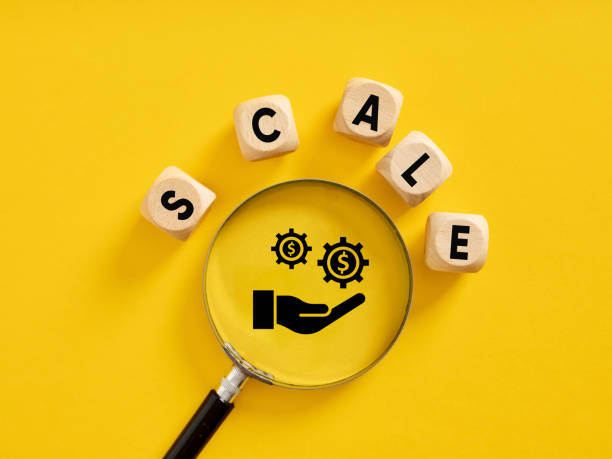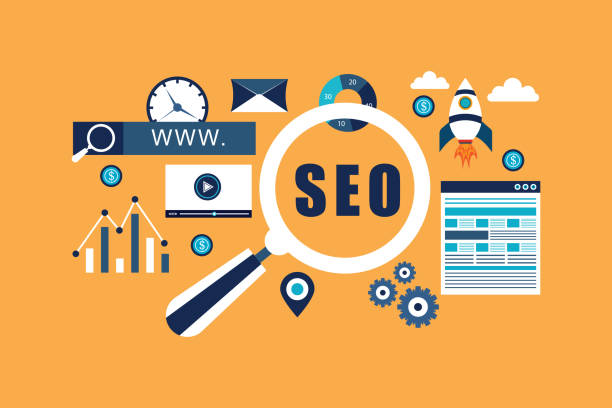What is On-Page SEO and Why is it Important?

What is On-Page SEO and Why is it Important?
#On-Page SEO refers to the set of actions you perform within your website to improve its ranking in search engine results like Google.
In other words, On-Page SEO is the optimization of elements such as content, site structure, keywords, and HTML tags for search engines.
Unlike Off-Page SEO, which involves actions outside your website such as link building, On-Page SEO is entirely under your control, which is why it holds special importance.
A site with strong On-Page SEO will have a greater chance of achieving a high ranking in search results and attracting more organic traffic.
The importance of On-Page SEO is summarized in the following points:
- Improved Site Ranking: On-Page SEO helps search engines better understand your site’s content, consequently improving your site’s ranking in search results.
- Attracting Organic Traffic: By improving site ranking, organic traffic (traffic that comes to your site through search results) increases.
- Enhanced User Experience: On-Page SEO includes actions like optimizing site speed and improving site structure, which contribute to a better user experience.
- Increased Conversion Rate: Organic traffic is usually high-quality traffic that has a higher likelihood of converting into customers.
In summary, On-Page SEO is a valuable investment that can help your business grow and succeed.
With strong On-Page SEO, you can solidify your position in the digital world.
Are you tired of your e-commerce site getting visitors but no sales? Rasaweb solves your core problem with professional e-commerce website design!
✅ Significant sales increase with targeted design
✅ Flawless user experience for your customers
⚡ Get a free consultation!
On-Page SEO Keyword Research

Keyword Research
Keyword research is the cornerstone of any successful On-Page SEO strategy.
This process involves identifying the words and phrases your target audience uses when searching for information related to your business on search engines.
By understanding these keywords, you can optimize your site’s content to rank higher in search results for these terms.
To start keyword research, you can use various tools such as Kparser, Ahrefs Keywords Explorer, Keywordtool.io, and Google Keyword Planner.
These tools help you find keywords relevant to your business, check their search volume, and assess the level of competition for each keyword.
When choosing keywords, pay attention to the following:
- Relevance: Keywords must be relevant to your site’s content.
- Search Volume: Keywords should have a respectable search volume to attract adequate traffic to your site.
- Competition: Keywords should not be overly competitive, unless you have sufficient resources to compete with larger sites.
Additionally, look for Long-Tail Keywords.
These are longer, more specific phrases that have lower search volume but typically higher conversion rates.
For example, instead of the keyword “shoes”, use the keyword “buy men’s athletic shoes size 42”.
Appropriate keywords help you attract your target audience.
Optimizing Titles and Meta Descriptions

Optimizing Titles and Meta Descriptions
Title Tags and Meta Descriptions are important On-Page SEO elements that help search engines and users understand what your page is about.
These elements are displayed in search results and play a crucial role in attracting user clicks to your site.
Titles should be short, engaging, and relevant to the page’s content.
Try to place your main keyword at the beginning of the title.
The title length should not exceed 60 characters.
Meta descriptions should provide an appealing and concise summary of the page’s content.
Use relevant keywords in your meta descriptions and try to entice users to click on your site’s link.
The meta description length should not exceed 160 characters.
Example:
- Title: Men’s Athletic Shoes – Online Sports Store
- Meta Description: Purchase the best men’s athletic shoes at affordable prices from our online sports store.
Fast shipping nationwide.
Here is an HTML table with CSS styling to display examples of optimized titles and meta descriptions:
| Page | Optimized Title | Optimized Meta Description |
|---|---|---|
| Store Homepage | Online Sports Equipment Store | Easy and Secure Shopping | Offering various original sports equipment at the best prices. Easy online shopping, secure payment, and fast nationwide delivery. |
| Men’s Athletic Shoes Purchase Page | Buy Men’s Athletic Shoes | Latest Models with Special Discounts | Original men’s athletic shoes from reputable brands at the best prices with free shipping. Shop now! |
Note that titles and meta descriptions should be unique for each page of your site.
Avoid copying titles and meta descriptions from other pages.
Optimizing Content for On-Page SEO

Optimizing Content for On-Page SEO
Content is King! This phrase is a fundamental principle in SEO.
High-quality and relevant content is not only valuable to users but also helps search engines understand your site’s topic and rank it in search results.
When creating content, pay attention to the following:
- Provide Valuable Information: Your content should offer useful information to users and answer their questions.
- Use Keywords: Naturally incorporate your keywords into the content.
Avoid overusing keywords, as this can harm your site’s SEO. - Appropriate Structure: Divide your content into smaller sections and use headings, subheadings, lists, and images to improve readability.
- Image Optimization: Choose relevant keywords for image file names and use alt tags to describe images.
- Internal Linking: Use internal linking to connect different pages within your site.
This helps search engines better understand your site’s structure.
In general, your content should be written for users, not for search engines.
By providing high-quality and relevant content, you can satisfy users and improve your site’s ranking in search results.
Producing high-quality content is one of the important pillars of SEO.
On-Page SEO helps your valuable content get better visibility.
Did you know that poor online store design can drive away up to 70% of your potential customers? Rasaweb transforms your sales with professional and user-friendly e-commerce website designs.
✅ Significant increase in sales and revenue
✅ Full optimization for search engines and mobile devices
⚡ [Get a free consultation from Rasaweb]
Optimizing Site Structure for SEO

Optimizing Site Structure for SEO
Your site’s structure plays a crucial role in On-Page SEO.
A well-organized and logical site structure helps search engines find and index your site’s pages more effectively.
Additionally, a good site structure helps users easily navigate your site and find the information they need.
To optimize your site’s structure, pay attention to the following:
- Use a Hierarchical Structure: Organize your site’s pages hierarchically.
The homepage should be at the highest level of the hierarchy, and sub-pages should be subsets of the homepage. - Create a Clear Navigation Menu: Create a clear and easy-to-use navigation menu that helps users easily access different pages of the site.
- Use SEO-Friendly URLs: Choose short, descriptive URLs for your site’s pages that contain relevant keywords.
- Create a Sitemap: Create a sitemap and submit it to Google.
A sitemap helps Google find and index your site’s pages more effectively. - Use Internal Linking: Use internal linking to connect different pages within your site.
This helps search engines better understand your site’s structure and guides users to relevant pages.
By optimizing your site’s structure, you can improve user experience and increase your site’s ranking in search results.
Good On-Page SEO ensures that Google finds your site more easily.
A site structure is very important in On-Page SEO.
Optimizing Website Speed

Optimizing Website Speed
Website speed is one of the important factors in site ranking in search results.
Users expect websites to load quickly, and if a site takes too long to load, the likelihood of users leaving the site and going to other sites increases.
Google also considers site speed as a ranking factor, and sites with high loading speeds achieve better rankings in search results.
To improve your site’s speed, you can use the following strategies:
- Optimize Images: Reduce image file sizes and use appropriate image formats.
- Enable Gzip Compression: Gzip compression reduces the size of your site’s files and increases loading speed.
- Use a CDN: A CDN (Content Delivery Network) stores your site’s content on various servers worldwide, helping users receive content from the nearest server.
- Reduce HTTP Requests: Minimize the number of HTTP requests.
The fewer HTTP requests, the faster your site will load. - Use Quality Hosting: Utilize high-quality hosting that offers high speed and stability.
To test your site’s speed, you can use various tools such as Google PageSpeed Insights and GTmetrix.
These tools help you identify your site’s speed issues and find solutions for improvement.
High speed plays an important role in user experience.
On-Page SEO helps you have a faster website.
Optimizing Website Mobile-Friendliness

Optimizing Website Mobile-Friendliness
Given the increasing use of mobile devices for internet searches, optimizing a website for mobile devices (Mobile-Friendly) is of particular importance.
Google also prioritizes mobile-friendly sites in search results.
A mobile-friendly site should display easily on mobile devices, allowing users to navigate it effortlessly and find the information they need.
To optimize your site’s mobile-friendliness, you can use the following strategies:
- Use Responsive Design: Employ responsive design so that your site automatically adapts to the screen size of various devices.
- Use Readable Fonts: Use readable fonts of appropriate size so that users can easily read your site’s content on mobile devices.
- Use Large and Touchable Buttons: Use large, easily tappable buttons so users can click them comfortably.
- Avoid Using Flash: Refrain from using Flash, as it is not supported on many mobile devices.
- Test the Site on Various Devices: Test your site on different mobile devices to ensure it displays correctly.
Google provides a tool to test website mobile-friendliness, which you can use to check your site.
By optimizing your site’s mobile-friendliness, you can improve user experience and increase your site’s ranking in search results.
Here is an HTML table with CSS styling to illustrate the differences between responsive design and non-responsive design:
| Feature | Responsive Design | Non-Responsive Design |
|---|---|---|
| Device Compatibility | Automatically adapts to device screen size | Requires zooming and scrolling on mobile devices |
| User Experience | Better and smoother user experience | Poor and difficult user experience |
| SEO | Approved by Google and improves site ranking | May decrease site ranking |
Using Structured Data (Schema Markup)

Using Structured Data (Schema Markup)
Structured Data (Schema Markup) are codes that help search engines better understand your site’s content.
By using structured data, you can provide additional information about your content to search engines, such as content type (article, product, event, etc.), author, publication date, and so on.
This information can help search engines make search results richer and more appealing, thereby increasing your site’s click-through rate (CTR).
To use structured data, you can employ various tools like Google Structured Data Markup Helper.
This tool helps you create structured data codes for different pages of your site and embed them within your site’s HTML.
Schema.org is a good resource for using this data.
On-Page SEO with structured data helps search engines better understand your site.
Is your company’s website as professional and trustworthy as it should be? With specialized corporate website design by Rasaweb, create an online presence that reflects your credibility and attracts more customers.
✅ Build a powerful and professional image for your brand
✅ Convert visitors into real customers
⚡ Get a free consultation now!
Fixing On-Page SEO Errors
![]()
Fixing On-Page SEO Errors
No website is perfect, and there is always a possibility of On-Page SEO errors.
Identifying and fixing these errors can help improve your site’s ranking in search results.
Some of the most common On-Page SEO errors include:
- Broken Links: Broken links are those that lead to pages that do not exist.
- Duplicate Content: Duplicate content refers to pages that have identical content.
- 404 Errors: 404 errors are pages that do not exist and are displayed when a user tries to access an invalid URL.
- Missing Title and Meta Description Tags: Pages without title and meta description tags prevent search engines from understanding what the page is about.
- Slow Site Speed: Slow site speed can lead to users leaving the site and a decrease in site ranking in search results.
To identify these errors, you can use various tools such as Google Search Console and Screaming Frog SEO Spider.
These tools help you identify your site’s On-Page SEO errors and find solutions to fix them.
By identifying and resolving these errors, you can improve your site’s On-Page SEO ranking.
On-Page SEO means fixing all site imperfections.
Fixing SEO errors is a continuous process.
Continuous Analysis and Improvement of On-Page SEO

Continuous Analysis and Improvement of On-Page SEO
SEO is an ongoing process and should not be a one-time task that is then abandoned.
After implementing On-Page SEO measures, you should continuously analyze your site’s performance and take necessary steps for improvement.
To analyze your site’s performance, you can use various tools such as Google Analytics and Google Search Console.
These tools help you review your site’s traffic, identify keywords through which users arrive at your site, assess the performance of different pages on your site, and pinpoint your site’s SEO issues.
Using this information, you can take the necessary actions to improve your site’s On-Page SEO.
For example, you can optimize your page content, target new keywords, enhance your site’s structure, boost your site’s speed, and fix On-Page SEO errors on your site.
SEO reporting is one of the most important tasks.
On-Page SEO should be continuously reviewed.
On-Page SEO is a process that makes your site more visible and attracts more traffic.
On-Page SEO helps search engines better understand your site’s content and present it to users.
By utilizing On-Page SEO, you can improve your site’s ranking in search results and increase your organic traffic.
On-Page SEO also helps you provide a better user experience for your site visitors.
By using the strategies provided in this article, you can improve your site’s On-Page SEO and achieve greater success.
Continuous effort is always needed to improve On-Page SEO.
On-Page SEO is a long-term investment that requires patience and perseverance to achieve desired results.
On-Page SEO helps you surpass your competitors.
Frequently Asked Questions
| Question | Answer |
|---|---|
| What is On-Page SEO? | It refers to the set of actions performed within a website to improve its ranking in search engines. |
| Why is On-Page SEO important? | Because it helps search engines better understand your site’s content and structure, and improves user experience. |
| What are the most important elements of On-Page SEO? | Title and meta descriptions, keywords, URL structure, quality content, image optimization, internal linking, and site speed. |
| How to optimize Title Tags and Meta Descriptions? | The title should include the main keyword and be engaging, and the meta description should be a compelling summary of the content with relevant keywords. |
| What is the role of keywords in On-Page SEO? | Keywords help search engines understand what the page’s content is about and should be used naturally and intelligently within the text. |
| How is image optimization done for On-Page SEO? | By compressing file size, using descriptive file names, and filling the Alt tag with relevant descriptions and keywords. |
| What is Internal Linking and what is its use? | It is the connection of different pages of the site to each other. This helps in distributing page authority and improving search engine crawling. |
| What is the importance of site loading speed in On-Page SEO? | High speed improves user experience and is one of the important ranking factors for search engines like Google. |
| What is the impact of site responsiveness (Mobile-Friendliness) on On-Page SEO? | Given the increase in mobile users, responsiveness is essential for providing a suitable user experience across all devices and for Google’s mobile-first indexing priority. |
| What are the important content-related factors in On-Page SEO? | Originality, quality, comprehensiveness, readability, proper use of headings (H1, H2,…), and regular content updates. |
And other services of Rasaweb Advertising Agency in the field of advertising
- Smart Social Media: An effective tool for online growth with the help of Google Ads management.
- Smart Sales Automation: An innovative service for increasing sales through marketing automation.
- Smart Custom Software: Transform online growth by optimizing key pages.
- Smart Advertorials: A creative platform for improving online growth with intelligent data analysis.
- Smart Website Development: Designed for businesses looking to increase sales through key page optimization.
And over hundreds of other services in the field of internet advertising, advertising consultation, and organizational solutions.
Internet Advertising | Advertising Strategy | Advertorials
Resources
Complete On-Page SEO TrainingImportance of Content in SEOFactors Affecting On-Page SEOSEO for Beginners
? For your business to soar in the digital world and reach the pinnacles of success, Rasaweb Afarin Digital Marketing Agency is with you, offering innovative services including website design with a modern user interface, SEO, and advertising campaign management, to ensure a powerful and lasting online presence.
📍 Tehran, Mirdamad Street, next to Bank Markazi, Kazeroon South Alley, Ramin Alley, No. 6



